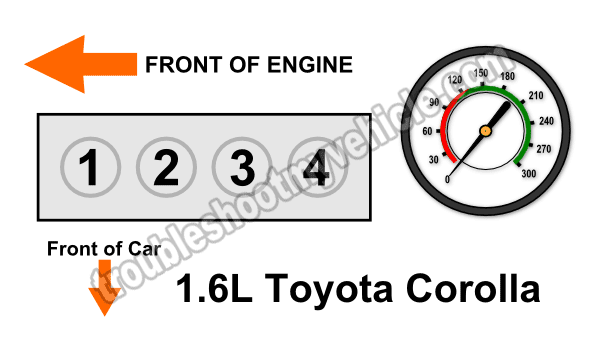TEST 2: Coolant Shooting Out From Open Radiator

Another common end-result of a blown head gasket is coolant shooting out of the radiator (with the cap removed) while you crank the engine.
This happens because the blown head gasket can no longer keep the combustion pressures (compression pressure, exhaust pressure, etc.) within the cylinder or cylinders as you crank the engine. As these pressures try to escape, via the cooling system, they forcefully push out the coolant out of the radiator.
IMPORTANT: Do not open the radiator with a hot engine. If your Corolla's engine has been running or is at operating temperature, you'll need to let the engine cool down completely before removing the radiator cap.
This is a very easy test to do and these are the test steps:
- 1
Remove the radiator's cap. Check to see if there is coolant in the radiator. If the radiator is empty, add some water or coolant to bring it up to the radiator's neck level.
- 2
Crank the engine with the help of helper, while you stand at a safe distance from the open radiator.
- 3
You'll see one of two results:
1.) The water or coolant inside the radiator will shoot up and out of the now open radiator.
2.) The coolant will not be disturbed. In other words, cranking the engine will have no effect on the level of the Water or coolant in the radiator.
OK, now that the testing part is done, let's take a look at what your results mean:
CASE 1: The coolant shot out from the radiator as you cranked the engine. This is a clear indication that the head gasket is blown.
The normal/correct test result is for the coolant to remain undisturbed no matter how long you crank the engine.
CASE 2: The coolant DID NOT bubble out NOR shoot out from the radiator: With this test result you can conclude that the head gasket is not letting the combustion pressures leak into the cooling system.
Your next step is a compression test. Go to: TEST 3: engine compression test.
TEST 3: Engine Compression Test

An engine compression test is probably one of the most neglected diagnostic tests for a blown head gasket. The test itself is not hard and can be done by the DIY'er.
If you don't have an engine compression tester, you can borrow one from your local auto parts store (AutoZone, O'Reilly Auto Parts, etc.).
What you're looking for with an engine compression test is to see if there are 2 side by side cylinders with 0 compression. 2 side-by-side cylinders with 0 compression are an indication that the head gasket has burned at the narrowest junction between the cylinders and is letting the compression of one cylinder escape into the other and vice-versa.
These are the test steps:
- 1
Remove all four spark plugs.
NOTE: If your specific Corolla has a distributor type ignition system, disconnect the distributor from its electrical connector. This will disable the ignition system and prevent spark from being created during the test. - 2
Thread in the compression tester by hand, on the first spark plug hole you're gonna' start with.
Do not use any tools to tighten the compression tester. Hand tightening the compression tester is more than enough to get the proper results. - 3
Have a helper crank the engine. Your job is to keep your eyeballs on the compression tester. The needle will climb, as the engine cranks, till it reaches the maximum cylinder compression. At the point it stops climbing, have your helper stop cranking the engine.
On a piece of paper, write down the reading and what cylinder it belongs to (you can use the image in the image viewer to help you identify the cylinder). Repeat the above steps in the remaining 3 cylinders.
Let's take a look at what your test results mean:
CASE 1: All cylinder compression readings where normal. These compression gauge readings confirm that the head gasket is OK and not burned at a point between two cylinders.
If you still suspect a blown head gasket. Go to: TEST 4: Using A Chemical Block Tester (Combustion Leak Tester).
CASE 2: Two side by side cylinders had 0 PSI compression. This engine compression reading confirms that the head gasket is burned thru' at the point between those two cylinders. You will need to replace the head gasket.

